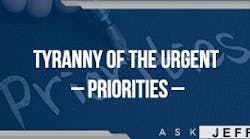Bruce, maintenance supervisor, Pennsylvania
Answer: Bruce, your question reminds me of a manufacturing site where I was asked to spend a couple of hours with the production supervisors to discuss how planning and scheduling should work within their environment. I asked nine supervisors who covered four different lines the question, “Whose line is most important”? There was no surprise when all nine raised their hands. Obviously, their focus is to meet the line production numbers, as that's how they are measured.
The reality is at any given time, we have a fixed pool of resources available to execute maintenance work. There must be a mechanism to prioritize our response. Here are some specific steps you can take to do so:
1. Develop a criticality ranking at the line level as a minimum or based on product mix. Communicate it. If things are somewhat fluid due to production line requirements, get an agreement about criticality the week before while in the weekly scheduling meeting and document it on the weekly maintenance schedule. This ranking will provide a tool for the maintenance supervisors. Most likely, a pattern for response will become evident over time, if it's not immediately obvious.
2. Establish and communicate a priority matrix. I like to think in terms of emergency (1), urgent (2), and routine planned work (3–6). Planned work has four rankings. The first planned priority (3) starts with PMs to break the reactive cycle. These PMs are generally not part of the backlog which follows. The second planned priority (4) addresses corrective work (60% of remaining available planned hours). The third planned priority (5) in descending order addresses needed but not required items (25%). The final fourth planned priority (6) is "breakaway" work assigned to reactive troubleshooters who handle emergencies (15% of the planned work). Everyone gets scheduled work.
Note that CMMS systems typically identify PMs as a specific work type, which makes adding priority codes seeming redundant. After seeing some sites place PMs at a lower priority than corrective work and projects, I started calling out the highest-priority code to that work in the hope that it would help get the work done. The priority code made it more visible.
I’ll add that I was using a similar approach previously and added the percentages with a little variance based on work from Sandy Dunn from Assetivity in Australia. By breaking up the planned work into separate priorities (versus simply lumping everything in as "routine"), you ensure that the low- and medium-priority work gets done in a timely manner. Many groups seem to find time only for the highest-priority work;they neglect low/mid-priority work. The response of those requesting lower-priority work is to re-enter the work as a safety work order to ensure that it gets done. What we want, however, is to instill confidence that we can execute all priorities.
3. Learn to say no. While it’s OK to break the schedule for higher-priority items, track schedule breakers, and look for opportunities to eliminate ones that could have been forecasted.
4. Enforce the items above using an audit process.
Is this your approach to priorities within your organization? How do service-level agreements regarding the target time to respond, i.e. 24 hours, 1 week, factor into your planning? Please post your comments or questions.
Talk soon,
Jeff Shiver, CMRP
If you have questions in the fields of maintenance, reliability, planning and scheduling, MRO storerooms, or leadership as examples, please contact Jeff Shiver with your question(s) here.


